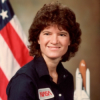Sally Ride

Sally Ride
Sally Kristen Ridewas an American physicist and astronaut. Born in Los Angeles, she joined NASA in 1978 and became the first American woman in space in 1983. She remains the youngest American astronaut to have traveled to space, having done so at the age of 32. After flying twice on the Orbiter Challenger, she left NASA in 1987. She worked for two years at Stanford University's Center for International Security and Arms Control, then at the University of California, San...
NationalityAmerican
ProfessionAstronaut
Date of Birth26 May 1951
CityLos Angeles, CA
CountryUnited States of America
It was hard to become an astronaut. Not anywhere near as much physical training as people imagine, but a lot of mental training, a lot of learning. You have to learn everything there is to know about the Space Shuttle and everything you are going to be doing, and everything you need to know if something goes wrong, and then once you have learned it all, you have to practice, practice, practice, practice, practice, practice, practice until everything is second nature, so it's a very, very difficult training, and it takes years.
If they asked me if I wanted to go into space tomorrow, I'd do it in a heartbeat. On the other hand, if they asked me if I wanted to go into training for three years and then go into space again, I'd probably say no.
I love the John Glenn model... I may call NASA in 25 years or so, and see if they'd like to send me to Mars.
So most astronauts are astronauts for a couple of years before they are assigned to a flight.
Once you are assigned to a flight, the whole crew is assigned at the same time, and then that crew trains together for a whole year to prepare for that flight.
It takes a few years to prepare for a space mission.
It takes a couple of years just to get the background and knowledge that you need before you can go into detailed training for your mission.
Women make up only 25 percent of the science, engineering and technology workforce... We are delighted to be working with NASA Ames to give Silicon Valley area girls a chance to explore and develop their potential in science at an age when many begin to drift away from their natural interest.
My parents didn't have a scientific bone in their body, and their daughter was pursuing a career in astrophysics. They didn't even know what astrophysics meant, but they supported me,
There are aspects of being the first woman in space that I'm not going to enjoy.
The women's movement had already paved the way, I think, for my coming.
Today, the astronaut corps is almost 25% female, ... and I want that to continue to rise.
If girls are interested, they have the potential to go further, ... There are still lingering stereotypes that affect girls in middle school, and they lose interest in the subjects.
There's a huge amount of pressure on every astronaut, because when you get right down to it, the experiments that are conducted on a space flight, or the satellites that are carried up, the work that's to be done, is important and expensive work, and you are up there for a week or two on a Space Shuttle flight. The country has invested a lot of money in you and your training, and the Space Shuttle and everything that's in it, and you have to do things correctly. You can't make a mistake during that week or two that you're in space.